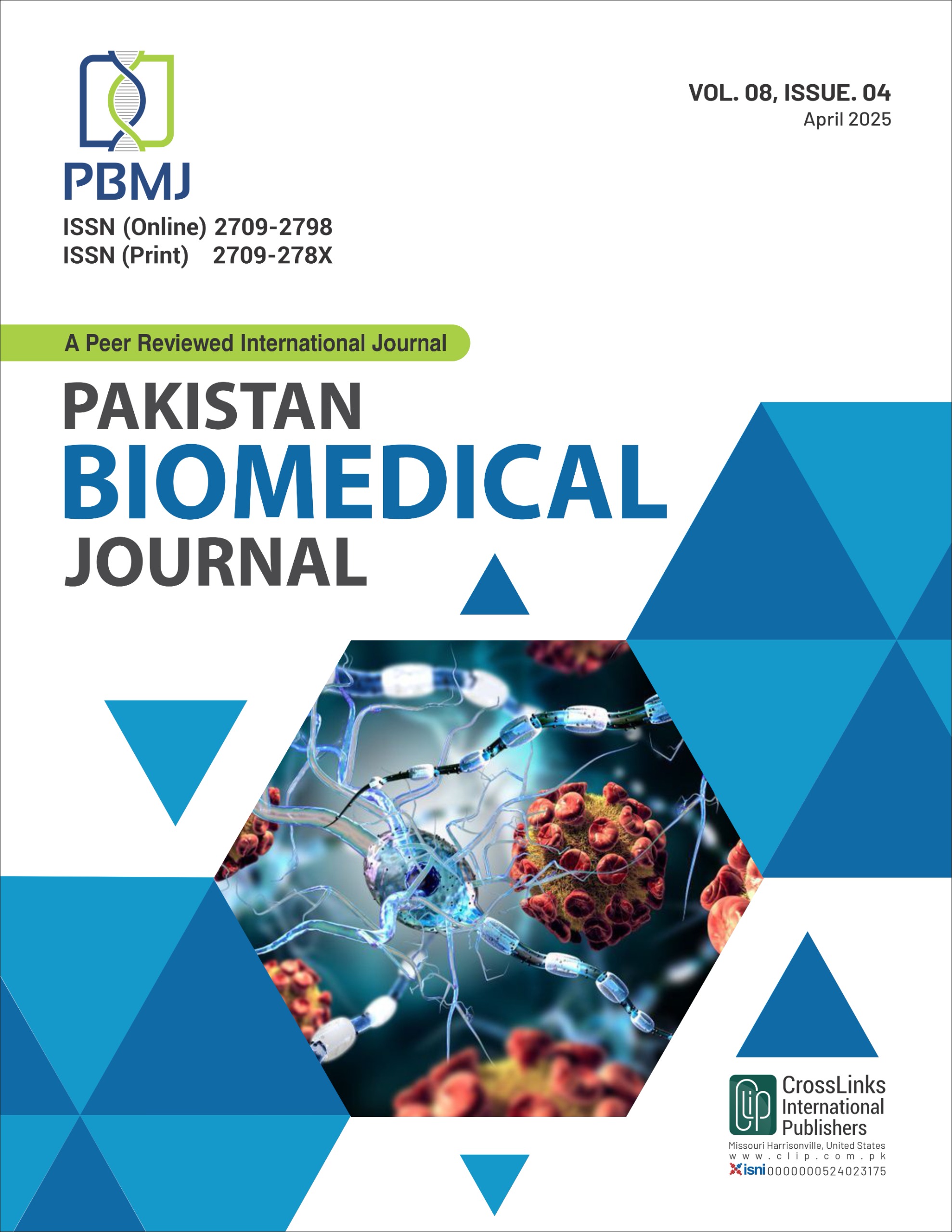Compare the Educational Environment and Prevalence of Myopia in Public and Private Schools
Educational Environment and Prevalence of Myopia
DOI:
https://doi.org/10.54393/pbmj.v8i4.1233Keywords:
Myopia, Mitigation, Educational Environment, PrevalenceAbstract
Myopia is a major cause of worldwide avoidable blindness, and its prevalence is increasing rapidly. Objectives: To investigate the relationship between myopia and educational environmental characteristics in public and private sectors. Methods: A cross-sectional study was conducted from August to December 2024, implementing a stratified sampling technique. Two schools were chosen at random from each of the public and private school strata. From each grade level, students were then selected at random. Individuals with ocular problems or those who declined to participate were not included. 621 students between the ages of 8 and 15 took part. Ocular examination included refraction and visual acuity. A self-structured questionnaire was utilized to assess the home and school educational environment variables. SPSS version 26.0 was used for data analysis. Results: Among 621 students (mean age 13 ± 1.89 years), 46.53% were male and 53.46% were female. 387 students attend public schools, while 234 attend private. 33.8% myopia prevalence, with 10% having high, 33.33% having moderate and 56.66% having mild myopia. There were 109 myopes from private schools and 101 from public schools. 109 out of 234 students in private schools (46.58%) have myopia. A pleasant study area and the amount of time spent on homework are all factors linked to myopia in public and private school types. Conclusions: It was concluded that a notable difference was found in the public and private sectors’ educational environments. More artificial lighting, fewer outside activities, and a stronger focus on digital learning resources like laptops and tablets are features associated with private schools.
References
Bourne RR, Flaxman SR, Braithwaite T, Cicinelli MV, Das A, Jonas JB et al. Magnitude, Temporal Trends, and Projections of the Global Prevalence of Blindness and Distance and Near Vision Impairment: A Systematic Review and Meta-Analysis. The Lancet Global Health. 2017 Sep; 5(9): e888-97.
Holden BA, Fricke TR, Wilson DA, Jong M, Naidoo KS, Sankaridurg P et al. Global prevalence of myopia and high myopia and temporal trends from 2000 through 2050. Ophthalmology. 2016 May; 123(5): 1036-42. doi: 10.1016/j.ophtha.2016.01.006. DOI: https://doi.org/10.1016/j.ophtha.2016.01.006
Sankaridurg P, Tahhan N, Kandel H, Naduvilath T, Zou H, Frick KD et al. IMI Impact of Myopia. Investigative Ophthalmology and Visual Science. 2021 Apr; 62(5): 2-. doi: 10.1167/iovs.62.5.2. DOI: https://doi.org/10.1167/iovs.62.5.2
Liang J, Pu Y, Chen J, Liu M, Ouyang B, Jin Z et al. Global Prevalence, Trend and Projection of Myopia in Children and Adolescents from 1990 to 2050: A Comprehensive Systematic Review and Meta-Analysis. British Journal of Ophthalmology. 2025 Mar; 109(3): 362-71. doi: 10.1136/bjo-2024-325427. DOI: https://doi.org/10.1136/bjo-2024-325427
Biswas S, El Kareh A, Qureshi M, Lee DM, Sun CH, Lam JS et al. The Influence of the Environment and Lifestyle On Myopia. Journal of Physiological Anthropology. 2024 Jan; 43(1): 7. doi: 10.1186/s40101-024-00354-7. DOI: https://doi.org/10.1186/s40101-024-00354-7
Li M, Lanca C, Tan CS, Foo LL, Sun CH, Yap F et al. Association of Time Outdoors and Patterns of Light Exposure with Myopia in Children. British Journal of Ophthalmology. 2023 Jan; 107(1): 133-9. doi: 10.1136/bjophthalmol-2021-318918. DOI: https://doi.org/10.1136/bjophthalmol-2021-318918
Gajjar S and Ostrin LA. A Systematic Review of Near Work and Myopia: Measurement, Relationships, Mechanisms and Clinical Corollaries. Acta Ophthalmologica. 2022 Jun; 100(4): 376-87. doi: 10.1111/aos.15043. DOI: https://doi.org/10.1111/aos.15043
Ding X, Morgan IG, Hu Y, Tang X, Zhang J, Guo L et al. The Causal Effect of Education on Myopia: Evidence That More Exposure to Schooling, Rather Than Increased Age, Causes the Onset of Myopia. Investigative Ophthalmology and Visual Science. 2023 Apr; 64(4): 25-. doi: 10.1167/iovs.64.4.25. DOI: https://doi.org/10.1167/iovs.64.4.25
Rashid F, Jabbar M, Fatima N, Siddique M, Hussain A, Waheed K. Effect of Change in Iris Colour on Myopia. Pakistan Journal of Medical and Health Sciences. 2022 May; 16(04): 289-. doi: 10.53350/pjmhs22164289. DOI: https://doi.org/10.53350/pjmhs22164289
Du Y, Meng J, He W, Qi J, Lu Y, Zhu X. Complications of High Myopia: An Update from Clinical Manifestations to Underlying Mechanisms. Advances in Ophthalmology Practice and Research. 2024 Jun. doi: 10.1016/j.aopr.2024.06.003. DOI: https://doi.org/10.1016/j.aopr.2024.06.003
Jiang F, Wang D, Xiao O, Guo X, Yin Q, Luo L et al. Four-Year Progression of Myopic Maculopathy in Children and Adolescents with High Myopia. Journal of the American Medical Association Ophthalmology. 2024 Mar; 142(3): 180-6. doi: 10.1001/jamaophthalmol.2023.6319. DOI: https://doi.org/10.1001/jamaophthalmol.2023.6319
Choi KY, Yu WY, Lam CH, Li ZC, Chin MP, Lakshmanan Y et al. Childhood Exposure to Constricted Living Space: A Possible Environmental Threat for Myopia Development. Ophthalmic and Physiological Optics. 2017 Sep; 37(5): 568-75. doi: 10.1111/opo.12397. DOI: https://doi.org/10.1111/opo.12397
Guan H, Yu NN, Wang H, Boswell M, Shi Y, Rozelle S et al. Impact of Various Types of Near Work and Time Spent Outdoors at Different Times of Day on Visual Acuity and Refractive Error Among Chinese School-Going Children. PLOS ONE. 2019 Apr; 14(4): e0215827. doi: 10.1371/journal.pone.0215827. DOI: https://doi.org/10.1371/journal.pone.0215827
Jabbar M, Siddiq S, Rashid F, Akhtar HM, Ali S, Iqbal RN et al. Exploring the Connection Between Myopia and Personality Traits: Myopia and Personality Traits. Pakistan Bio-Medical Journal. 2024 May: 25-9. doi: 10.54393/pbmj.v7i05.1090. DOI: https://doi.org/10.54393/pbmj.v7i05.1090
Morgan IG, French AN, Ashby RS, Guo X, Ding X, He M et al. The Epidemics of Myopia: Aetiology and Prevention. Progress in Retinal and Eye Research. 2018 Jan; 62: 134-49. doi: 10.1016/j.preteyeres.2017.09.004. DOI: https://doi.org/10.1016/j.preteyeres.2017.09.004
Mirshahi A, Ponto KA, Hoehn R, Zwiener I, Zeller T, Lackner K et al. Myopia and Level of Education: Results from the Gutenberg Health Study. Ophthalmology. 2014 Oct; 121(10): 2047-52. doi: 10.1016/j.ophtha.2014.04.017. DOI: https://doi.org/10.1016/j.ophtha.2014.04.017
Morgan IG and Rose KA. Myopia and International Educational Performance. Ophthalmic and Physiological Optics. 2013 May; 33(3): 329-38. doi: 10.1111/opo.12040. DOI: https://doi.org/10.1111/opo.12040
George AS, George AH, Shahul A. The Myopia Epidemic: A Growing Public Health Crisis Impacting Children Worldwide. Partners Universal International Research Journal. 2023 Sep; 2(3): 120-38.
Philipp D, Vogel M, Brandt M, Rauscher FG, Hiemisch A, Wahl S et al. The Relationship Between Myopia and Near Work, Time Outdoors and Socioeconomic Status in Children and Adolescents. BioMed Central Public Health. 2022 Nov; 22(1): 2058. doi: 10.1186/s12889-022-14377-1. DOI: https://doi.org/10.1186/s12889-022-14377-1
Dhakal R, Shah R, Huntjens B, Verkicharla PK, Lawrenson JG. Time Spent Outdoors as an Intervention for Myopia Prevention and Control in Children: An Overview of Systematic Reviews. Ophthalmic and Physiological Optics. 2022 May; 42(3): 545-58. doi: 10.1111/opo.12945. DOI: https://doi.org/10.1111/opo.12945
Wang M, Peng X, Cai Y. A Multi-Metric Evaluation of Classroom Daylighting: Integrating Myopia Prevention and Visual Comfort. Journal of Building Engineering. 2025 Apr; 99: 111616. doi: 10.1016/j.jobe.2024.111616 DOI: https://doi.org/10.1016/j.jobe.2024.111616
Downloads
Published
How to Cite
Issue
Section
License
Copyright (c) 2025 Pakistan BioMedical Journal

This work is licensed under a Creative Commons Attribution 4.0 International License.
This is an open-access journal and all the published articles / items are distributed under the terms of the Creative Commons Attribution License, which permits unrestricted use, distribution, and reproduction in any medium, provided the original author and source are credited. For comments editor@pakistanbmj.com











